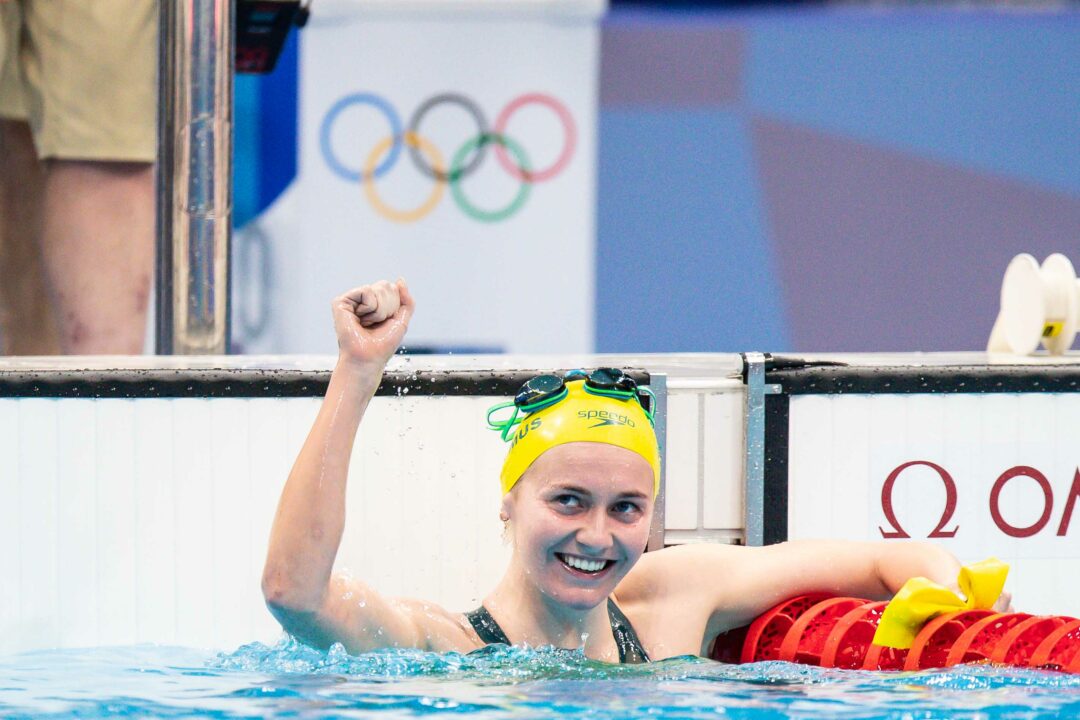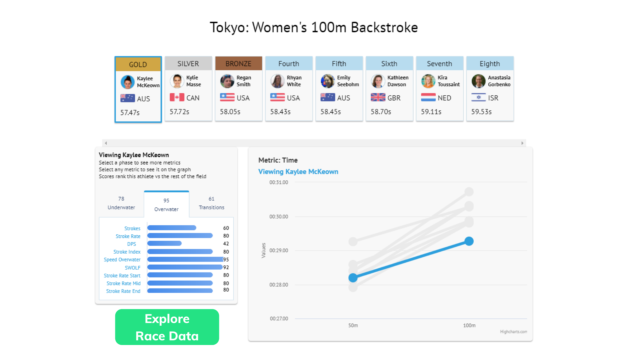We asked our swimming data partner TritonWear to help us with a deeper insight into performances and what makes elite swimmers fast and where they can improve. This is their TritonWear analysis.
Australia’s swimming sensation Ariarne Titmus paces like a Swiss watch and takes the gold ahead of Haughey (silver) and Oleksiak (bronze) just two days after snagging the win from Ledecky and being crowned the 400 Freestyle champion.
The all-star heat included two world record holders Frederica Pellegrini (200m Freestyle) and Katie Ledecky (400m Freestyle). It was one to go down in history. Pellegrini, the 32-year-old Italian, was the first woman ever to qualify in this event for five consecutive career finals – living up to her legend status once more. But she was not the only one making history in that final. Penny Oleksiak gave Canadians a night to remember. Her bronze is her sixth medal ever solidifying her as the most decorated summer Olympian in Canada.
Ready to be blown out of the water? Check out how these legends’ data rank for each of their swimming phases (transitions, underwater, overwater).
For this analysis, we’re using the same TritonWear data 30+ national federations trust when training elite athletes, bringing you all the insights into faster swimming.
So, let’s dive right in and nerd out on all things data. Getting off to a flying start was Katie Ledecky with the best Dive Block Time (reaction time) of 0.62s and a Dive Hang Time (flight) of 0.35s. She can take off fast, and also stay in flying mode longer, thus gaining more distance before her point of entry.
Conversely, her top-notch start does not translate to the highest Speed Underwater (3.28m/s) on the first lap, where she ranks 3rd after Oleksiak (3.43m/s) and Haughey (3.47m/s).
As for turns, Titmus steals the spotlight with the fastest Transition Time average of 1.54s. What’s interesting here is the difference in Transition Time of 0.42s between her and Wilson who took the longest time in and out of the turns. Furthermore, Titmus’s unmatched turns place her second in the charge underwater.
Transition metrics measure performance, skills and speed during entry and turning. Specifically, it tracks: Transition Time, Turn Time, Turn Rate, Push-off Time, Push Max Acceleration, Push Strength, Dive Time, Dive Hang Time, Dive Block Time. By transitions, we mean ALL the points of change in and out of swimming, including starts, turns, and push-offs.
Subsequently, clocking the fastest Speed Underwater average and showing the younglings how it’s done is Frederica Pellegrini at 3.16m/s, 0.57m/s faster than Seemanova’s average of 2.59m/s.
Looking further into the rest of the underwater metrics despite her lower Speed Underwater Seemanova managed to spend the most Time Underwater (2.85 s), and had the highest Percent Underwater (10.67%), on an average, surfacing further than anyone.
*In the underwater phase, users can track performance using metrics like: Push Depth, Underwater Time, Speed Underwater, Percent Underwater, Max Depth Underwater.
Lastly, on the overwater swimming, Ledecky’s fine-tuned freestyle technique and body position allow her to catch water and build momentum with every stroke. A true testament in her ability to hold her SR from Start to Mid to End (51.03- 51.48- 50.06 cyc/min) showing how well connected her strokes are.
In the Overwater phase, you can track your performance using specific metrics like Strokes, Breaths, Stroke Rate, Intra-cycle Variation, Distance Per Stroke, Stroke Index, Swolf, Overwater Time, and Speed Overwater.
FUN FACT: Ariarne Titmus nails her splits (27.04- 28.81-28.85-28.80) by holding a faster overall Average Speed of 1.75 m/s. Her unparalleled precision in her Average Speed by lap: 1.85 -1.74-1.73- 1.74 (m/s) sets her a head above her competition.
Draw Your own Conclusions
Head over to TritonWear’s epic Race Analysis page
to explore every detail of each swimmer’s race data.
We understand that not all coaches and swimmers are data-heads. Analyzing data requires a lot of time and effort that, frankly, most just don’t have. At TritonWear, we strive to make data quick, easy, and fun to use so you can focus on swimming and leave the number-crunching to us.
With a glance at the Triton Score, you’ll know instantly how well you trained and even get personalized feedback highlighting exactly where you’re excelling and what you need to improve on to swim faster.
Athletes: Get started with as little as $20/month and receive a free unit (included with your membership).
Coaches: Create highly personalized winning strategies for individual swimmers and the team with data-driven insights. 30+ national federations trust us to help them train these elite athletes; you can too. * Volume prices apply.
About TritonWear
TritonWear is a sleek wearable device and app that helps you train well consistently, so you can swim faster. It captures and relays 30+ data points in real-time to any mobile device on deck. Triton Score analyzes your data and provides you with actionable insights highlighting exactly where you’re excelling and what you need to improve on to swim faster.







“swimming sensation Ariarne Titmus paces like a Swiss watch”
That was the weirdest split I’ve ever seen. I’m ready to bet that it wasn’t intentionally designed by coach and she simply deviated from the race plan not being able to keep close to it.
If you check the approach to the 200FR race by swimmers who were able to make it under 1:55 then you will find three main type of strategies
1. Sprinters – very fast first half and then whatever it would be (just don’t die). The last fifty in this case is usually slower than 30sec. You can see it with Franklin, McKeon, Yang, Haughey
2. Camel shape splits curve. Focusing on exceptionally… Read more »
I agree with you and her being another second slower in the 4×200 supports your theory that she was experiencing fatigue. We need to remember there were no semis at trials and the heats at trials were also slower so less costly to navigate.
Yeah. I don’t like comments blaming Titmus in losing gold medal in 4×200 relay. Suddenly 1:54.5 became a choking. Just two months ago it was a very decent time that could medal in Tokyo.
Slowly but surely W200FR is moving into 1:53 zone. Swimming 1:54 won’t be exotic anymore and will be must do time for medal contenders.
But for now it’s a tough area and slightest deviation from a perfect form can bring you far away from your best.
Ledecky was fatigued for the 200 final so it is also dependant on the scheduling.
Yes. Always wondered why the 400 free and 200 free are so close in the scheduling
She’s amazing
Great splits.soo consistent. She doesn’t really slow down unlike her competitors. Same with Zac S-C . Probably same as most of the winners.
I’m guessing you have the data, so do you know if there’s a positive correlation between time spent underwater and average speed underwater? My guess is there is, based on the fact that the speed right after the push-off is faster and the longer you spend underwater the less it contributes to the average.